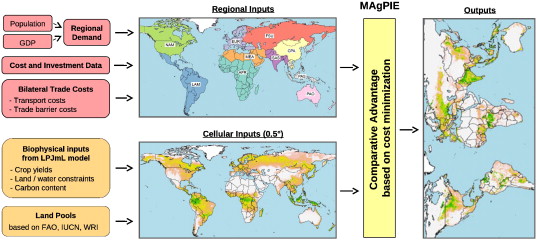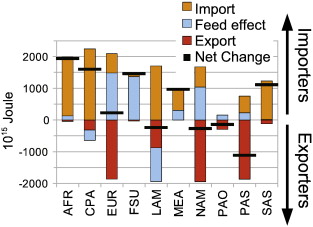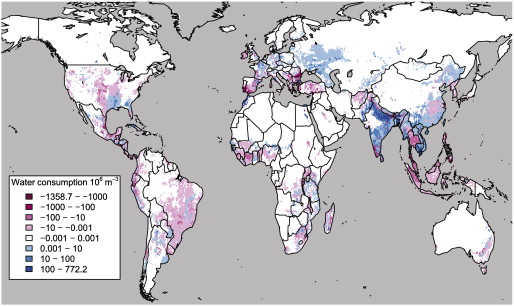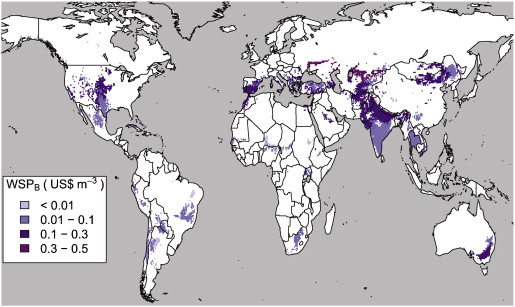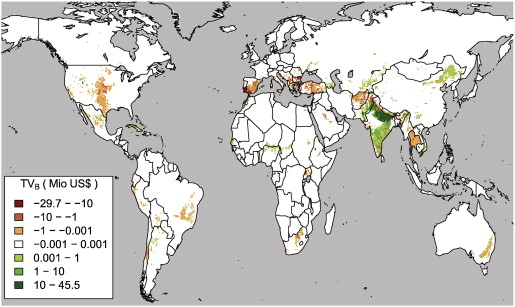The following is an article by the Potsdam Institute for Climate Impact Research, posted March 18, 2014, with the title above:
International trade of food crops led to freshwater savings worth 2.4 billion US-Dollars in 2005 and had a major impact on local water stress. This is shown in a new study by the Potsdam Institute for Climate Impact Research. Trading food involves the trade of virtually embedded water used for production, and the amount of that water depends heavily on the climatic conditions in the production region: It takes, for instance, 2.700 liters of water to produce 1 kilo of cereals in Morocco, while the same kilo produced in Germany uses up only 520 liters. Analyzing the impact of trade on local water scarcity, our scientists found that it is not the amount of water used that counts most, but the origin of the water. While parts of India or the Middle East alleviate their water scarcity through importing crops, some countries in Southern Europe export agricultural goods from water-scarce sites, thus increasing local water stress.
“Agriculture accounts for 70 percent of our global freshwater consumption and therefore has a huge potential to affect local water scarcity,” lead author Anne Biewald says. The amount of water used in the production of agricultural export goods is referred to as virtual water trade. So far, however, the concept of virtual water could not identify the regional water source, but used national or even global averages instead. “Our analysis shows that it is not the amount of water that matters, but whether global food trade leads to conserving or depleting water reserves in water-scarce regions,” Biewald says.
Combining biophysical simulations of the virtual water content of crop production with agro-economic land-use and water-use simulations, the scientists were able for the first time to determine the positive and negative impacts on water scarcity through international trade of crops, livestock, and feed. The effects were analyzed with high resolution on a subnational level to account for large countries like India or the US with different climatic zones and relating varying local conditions regarding water availability and water productivity. Previously, these countries could only be evaluated through national average water productivity. “Local water scarcity is reduced through imports of agricultural goods, and therefore saving regional agricultural production particularly in parts of India, Morocco, Egypt, and Pakistan. But scarcity is exacerbated by exports in parts of Turkey, Spain, Portugal, Afghanistan, and the US,” Biewald says. Despite the fact that Europe alone exports virtual water in food crops worth 3.1 billion US-Dollars, the scientists found that international trade of food crops today globally accounts for water savings worth 2.4 billion US-Dollars.
The study, focusing on data of the year 2005, shows that trade has a considerable impact on agricultural production. Trade reduces global crop production and area due to regionally different livestock production efficiencies: one kilo of beef for instance can be produced with much less input feed in the US than in Africa, so it might be more economical for the world to have regions specializing in certain products and exporting them to others. “In contrast to popular perception, global food trade and the related virtual water flows indeed offer the possibility of relieving water stress and making global water use more efficient,” co-author Hermann Lotze-Campen, co-chair of PIK´s research domain Climate Impacts and Vulnerabilities, says. “When it comes to the implementation of policy instruments which affect global trade – such as trade liberalization, import taxes, or agricultural subsidies, decision makers have to take into account the indirect effects on water as well. To connect international food trade to regional water scarcity can contribute to advance this debate.” Article: Biewald, A., Rolinski, S., Lotze-Campen, H., Schmitz, C., Dietrich, J.P (2014): Valueing the impact of trade on local blue water. Ecological Economics, Volume 101 [10.1016/j.ecolecon.2014.02.003].
Editor’s note: Many thanks to Professor Leila Carvalho for suggesting this material.

